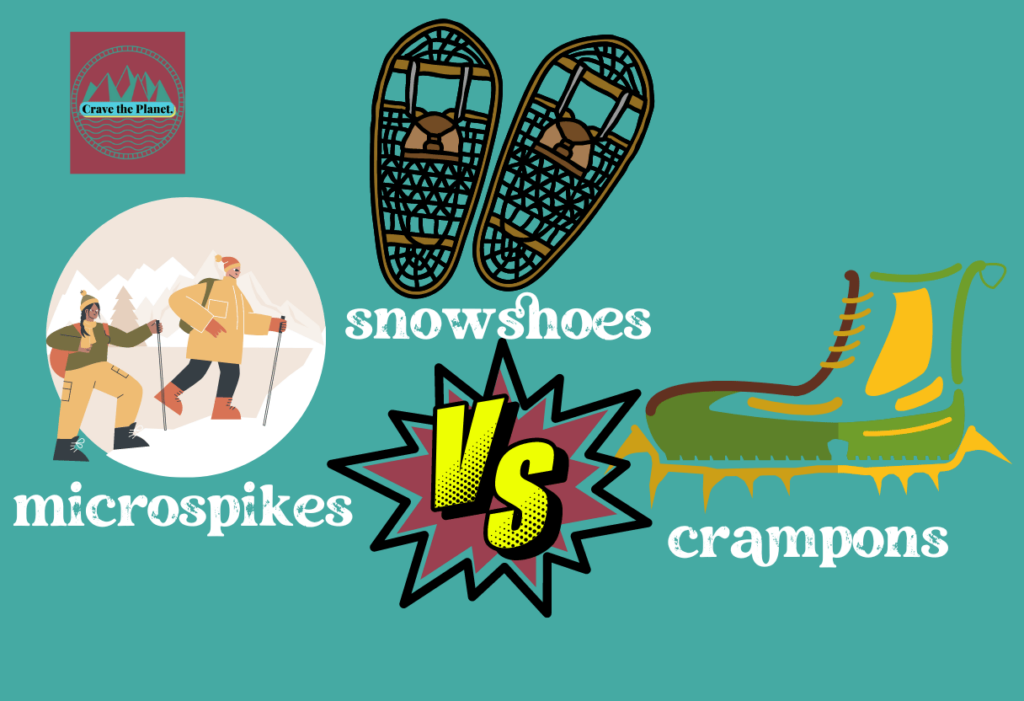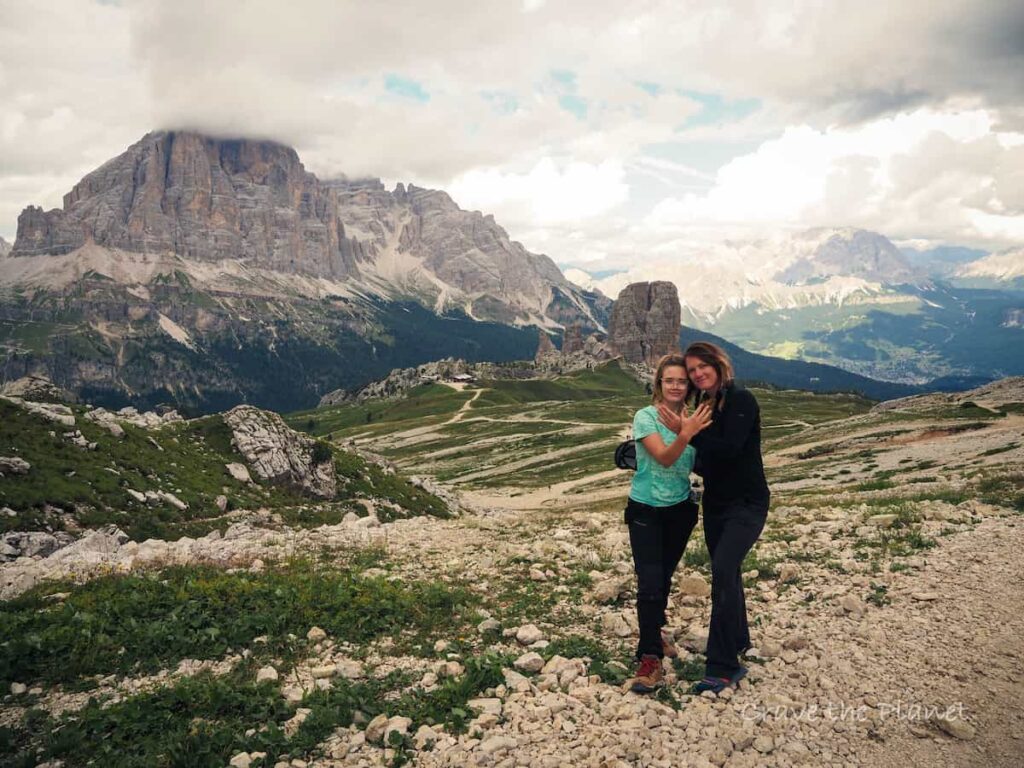When you lace up your winter boots and set out on snow-covered trails, you may wonder whether to arm yourself with microspikes, crampons, or snowshoes to tackle icy paths confidently.
With two decades of experience traversing the wintry landscape, knowledge in outdoor retail, and a passion for sharing insights on winter hiking gear, the guidance provided here is aimed to help you understand when and how to use these critical winter traction devices.
Each tool—microspikes, crampons, and snowshoes—has its unique advantages, and choosing the right one can transform your winter hike into a safe and exhilarating experience.
👉 Not sure? Take my quiz to find out!

Take the Quiz
What’s the Right Winter Traction for You?
👉 All adventures at your own risk and your mileage may vary, use your best judgement.
Author's TL;DR:
- Understanding the distinction between microspikes, crampons, and snowshoes ensures a safer hiking experience.
- Choosing the appropriate traction device depends on the specific conditions of your winter hike.
- Selecting the right gear enhances comfort and safety on icy and snowy trails.
Their packability makes microspikes a favored option for light travel, while the bulkiness of snowshoes may hinder transport.
Microspikes vs Crampons Vs Snowshoes
- Microspikes offer excellent footwear compatibility and ease of use, making them a consistent choice for varied terrain.
- Crampons provide superior traction and are optimal for icy conditions and steep slopes, but they require more effort to attach and may not fit all footwear.
- Snowshoes excel in deep snow with their unparalleled flotation but provide less grip on icy surfaces and can be cumbersome.
In terms of affordability, microspikes generally present a more cost-effective solution compared to the others.
When considering durability, crampons and snowshoes are reliable long-term investments, offering excellent resilience.
3 Shoe Traction Tools for Winter Terrain
The Essence of Microspikes
Microspikes are traction devices that fit snugly around your footwear.
These are primarily designed for icy or snow-packed surfaces.
Ideal Situations for Microspike Usage
You should consider microspikes for terrain that is icy or has hard-packed snow.
They are not suitable for steep slopes or deep snow where you require more grip and flotation.
Top Choices for Microspike Selection
Among traction devices, Kahtoola Microspikes stand out as a robust option.
On the other hand, Hillsound Trail Crampon Ultra offers an improved fit with its velcro toe strap, presenting a favorable alternative.
Read ➡️ The Best Microspikes for Hiking
What are Crampons Good For?
The Basis of Crampons
Crampons are essentially metal frames with spiked protrusions that are secured under your mountaineering boots.
Spikes, varying in number, extend from the frame, typically with longer ones at the front, enabling a firmer grip on slippery surfaces.
They are designed to assist you when moving across icy terrains, such as frozen waterfalls and steep slopes, by providing additional stability and traction.
Appropriate Scenarios for Crampon Use
You should consider strapping on crampons when facing steep inclines covered with ice or hardened snow, where a misstep could have serious consequences.
They are indispensable for ice climbing and mountaineering excursions.
Gaining the proficiency to use them properly calls for training, as there is an art to walking and ascending with crampons attached to your boots.
Recommended Crampons
For those regularly braving the harshness of alpine environments, the Black Diamond Sabretooth Clip Crampons stands out as a hardy and versatile option.
These step-in style crampons offer a reliable attachment to your boots, suitable for a range of conditions short of vertical ice climbing.
Conversely, the Kahtoola K 10 and Hillsound Trail Crampon Pro offer economical options for less technical terrain, ideal for hikers needing additional grip on slippery slopes.
Read ➡️ Roundup of the Best Crampons
Exploring Snowshoes
Snowshoe Basics
Snowshoes are designed to increase the size of your footprint, allowing you to stay atop snow rather than sinking into it. There are two common types: one featuring a solid, unified deck and another with a perimeter frame connected to a laced or fabric deck.
Snowshoe bindings consist of straps that secure a wide range of footwear, offering versatility. Most models have some form of underfoot traction, particularly beneath the toes, to assist with slippery surfaces.
Appropriate Conditions for Snowshoeing
Snowshoes are most effective in conditions with deep and fresh snow, as they provide the necessary flotation. They're not as useful on hard-packed, shallow snow or icy terrain, where their wide platforms can cause slipping hazards.
Recommended Snowshoes
For over two decades of experience, MSR snowshoes stand out for their durability and ease of use. The MSR Evo Trail is an excellent value offering, while the MSR Lightning Ascent is a premium option with lighter weight and enhanced comfort.
Snowshoeing is a fun winter activity that lets you traverse flat or mountainous terrain without sinking into powder.
Keep in mind, in the backcountry or freshly fallen snow, snowshoeing can prevent the arduous task of postholing.
Snowshoes utilize increased surface area for better flotation, making them ideal for exploring packed snow as well as powdery, deep snow conditions.
Whether you are a beginner or an experienced enthusiast, selecting the right snowshoes, like the MSR Lightning Ascent or the Tubbs models, will enhance your snowshoeing experience.
Always consider the type of terrain and the snow conditions you'll be encountering to ensure a safe and enjoyable trip.
Additional Winter Traction Aids
When considering traction devices for winter, numerous options are available, but not all offer the same level of stability. Most are built for urban environments and may not provide the grip strength that crampons or microspikes do.
Kahtoola NANOspikes feature a harness system that is comparable to microspikes but include small metal studs attached to rubber plates underfoot. Be mindful that snow can accumulate under these rubber plates, potentially compromising traction.
In contrast, Kahtoola EXOspikes come with a similar harness and feature more aggressive studs than NANOspikes. The reduced rubber underfoot in this design helps decrease the likelihood of snow buildup.
It's also essential to maintain safety during winter commutes and navigate icy conditions with care. To lower the risk of falls, consider perusing recommendations for keeping your feet secure on slippery surfaces.
Ski Touring and Cross Country Skiing
There are incredible advances in the ski boot technology and more and more people are skipping the shoeshoes and utilizing a flex boot with ski touring bindings.
Deciding on the appropriate traction device for winter excursions is crucial. For varied terrain encountered during winter hikes, you might consider packing microspikes, even as a complement to snowshoes, to manage steep inclines.
When planning your winter activities, ensure your footwear is equipped to handle the conditions you'll encounter. Obtaining the right traction device is an essential step in preparing for safe winter excursions.
Common Winter Traction Devices Queries
Comparing Microspikes, Crampons, and Snowshoes
When deciding between microspikes, crampons, and snowshoes, it's essential to note they serve different purposes. Microspikes are ideal for icy paths and light snow. They attach to your footwear with small spikes for grip.
Crampons have larger, more aggressive spikes and are designed for challenging ice and steeper terrain. They require compatible boots and more skill to use safely.
Snowshoes spread your weight over a large area, preventing sinking in deep snow. They provide flotation and stable footing but are not intended for ice climbing.
Selection Criteria for Winter Traction Gear
To choose the correct traction device for winter hiking, assess the terrain and snow conditions.
For maintained trails with compact snow, microspikes often suffice.
For more uneven, icy surfaces, or when mountaineering, crampons provide the necessary grip and stability.
In deep, powdery snow, snowshoes will be your best option to stay atop the snow and conserve energy.
When to Opt for Crampons Instead of Microspikes
Utilize crampons over microspikes when facing steep, icy, or more technical terrain.
Crampons offer the security and penetration needed for firmer ice that microspikes cannot reliably provide.
Benefits of Snowshoes in Deep Snow
Snowshoes excel in deep snow by increasing your surface area, which prevents sinking and makes progress easier.
They often feature cleats or rails for additional traction on slopes and stability in variable snow conditions.
Adequacy of Microspikes for Winter Trails
Microspikes are typically suitable for well-traveled trails with packed snow or moderate ice.
They provide enhanced traction for normal winter walking without the technical features of crampons.
Concurrent Use of Crampons and Snowshoes
While crampons and snowshoes serve different purposes, they can be used in tandem during an outing.
Snowshoes can be worn while trekking through deep snow, and when encountering ice or steep terrain, they can be swapped for crampons for improved safety and grip.
More Buying Guides for Hikers
Why Trust?

At Crave the Planet, I'm all about honest and relatable reviews of outdoor products. As a physical therapist, hut to hut hiker, downhill skier and mom, I'm constantly trying new gear to make my outdoor experiences more comfy and fun but with science in mind.
I'll be real with you, I don't do every outdoor activity. But, who does? I'm just a regular person who loves exploring the planet. Perfectionism is my enemy and I hope to help you ditch that vibe too.
My review process involves testing each product in real-life outdoor situations, but if it's a really horrible day I'll probably find a hotel in the valley. I'll let you know what worked for me and what didn't, so you can make informed decisions about your gear choices.
I don't do sponsored reviews or take payment for my reviews. All comments are based on my personal experience. Sometimes I'll test something and then send it back for a refund. Usually there's a hefty fee. Bummer. So, if you're looking for a relatable and honest take on outdoor gear, you're in the right place.
More Resources
Discover gear that elevates your outdoor adventures. As a physical therapist, I've curated product comparisons to enhance safety and enjoyment, perfect for beginners or those with weary knees.
Physical Therapist Curated Gear Guides for Hikers & Skiers
- 🧎 Make your knees feel better while hiking and walking: Best Knee Braces for Hiking
- 🌳Make the downhills stop hurting and hike with more confidence Best Trekking Poles Review
- ⌚ Never get lost on the trail and navigate the wilderness safely with My Review of the Best GPS Watches for Hiking
- ❄️ Go hiking on uneven terrain safely: The Best Hiking Boots with Ankle Support
- Don't get lost in the backcountry with : My Review of the Best 2 Way Radios for the Mountains

My Guides to Bucketlist Hikes in Europe
(That I've personally done and loved.)
In summary, microspikes, crampons, and snowshoes each play a specific role in winter adventures. By understanding their differences and applications, you can select the appropriate equipment to ensure safety, comfort, and enjoyment in the snowy outdoors.

Author profile: Morgan Fielder is a Doctor of Physical Therapy and passionate hiker who believes in exploring the world on foot with good food. Follow her journey as she shares science-based hiking tips and advocates for sustainable tourism.
